The Seville Spring Fair - "Feria de Abril"
Every year,
two weeks after Easter, a festival is held in Seville. For its duration,
a vast area is on the far bank of the river - the Real de la Feria -
is totally covered in rows of casetas which are canvas pavilions or
tents of varying sizes; there are hundreds of them. Some of belong to
eminent Sevillano families, some to groups of friends, others to clubs,
trade associations or political parties. The Feria can trace its origins
back to 1847, but by the 1920s it had reached its peak with its layout
similar to a small town with streets and 'houses'. In 2003 there were
over 1,000 casetas and 15 main roads.
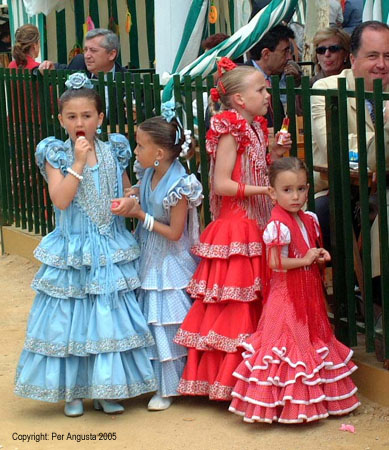 Many
of the men and virtually all the women wear traditional costume, the
latter in an astonishing array of brilliantly coloured, flounced gypsy
dresses. At first, you just think that a flamenco dress is a flamenco
dress is a flamenco dress but as the days went by we began to realise
that there were a multitude of different styles. A
visit to the local department stores confirmed this. In the dress department
there was virtually a whole floor devoted to the dresses, shoes and
accessories. You can buy the skirts separately with matching or contrasting
tops. The dresses are incredibly heavy.
Many
of the men and virtually all the women wear traditional costume, the
latter in an astonishing array of brilliantly coloured, flounced gypsy
dresses. At first, you just think that a flamenco dress is a flamenco
dress is a flamenco dress but as the days went by we began to realise
that there were a multitude of different styles. A
visit to the local department stores confirmed this. In the dress department
there was virtually a whole floor devoted to the dresses, shoes and
accessories. You can buy the skirts separately with matching or contrasting
tops. The dresses are incredibly heavy.
The sheer size
of this spectacle is extraordinary and everyone is there to enjoy th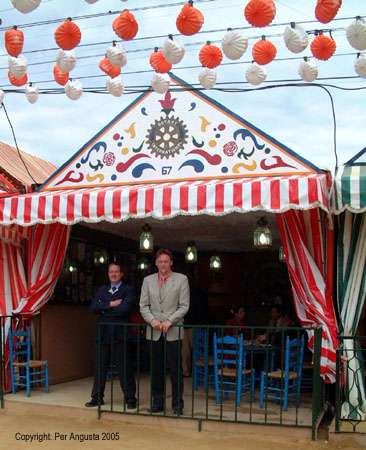 emselves.
Most of the casetas are private and you need to belong to the club which
has set it up or have been invited to enter. However, there are a few
open casetas and you can join in the drinking and dancing in one of
these as they have commercial bars. The 'caseta municipal' is run by
the town hall, and is one of the largest and always open to everyone,
but it can be completely full if a well known band or singer is on stage.
If you are a member of club or
society which is operating the caseta - or you are invited in as we
were - you don't have to pay for the food or the drink. The most popular
drink was sherry - a very dry fino. In the afternoon, it is drunk with
Seven Up, in the evening neat and ice cold. They don't just give you
a glass - you get given a whole bottle (about 20cl).
emselves.
Most of the casetas are private and you need to belong to the club which
has set it up or have been invited to enter. However, there are a few
open casetas and you can join in the drinking and dancing in one of
these as they have commercial bars. The 'caseta municipal' is run by
the town hall, and is one of the largest and always open to everyone,
but it can be completely full if a well known band or singer is on stage.
If you are a member of club or
society which is operating the caseta - or you are invited in as we
were - you don't have to pay for the food or the drink. The most popular
drink was sherry - a very dry fino. In the afternoon, it is drunk with
Seven Up, in the evening neat and ice cold. They don't just give you
a glass - you get given a whole bottle (about 20cl).
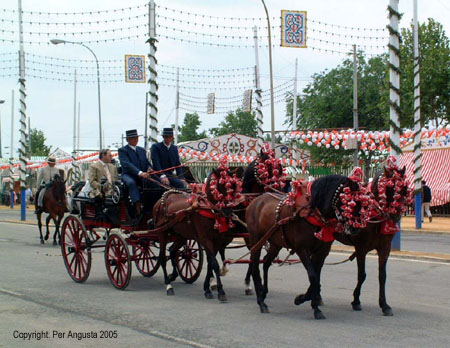 From
around midday until early evening, Seville society parades around the
fairground in carriages or on horseback. It starts off fairly sedate
and uncrowded.But as
the day goes on, it gets more and more
crowded and you get grid lock.
From
around midday until early evening, Seville society parades around the
fairground in carriages or on horseback. It starts off fairly sedate
and uncrowded.But as
the day goes on, it gets more and more
crowded and you get grid lock.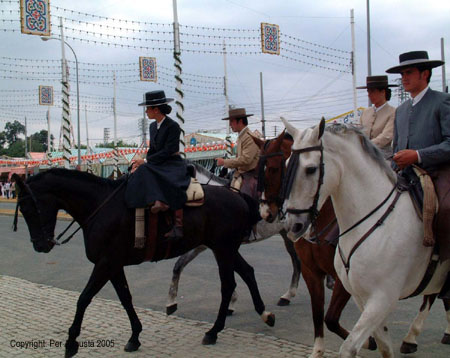 The horses are absolutely magnificent and in wonderful condition. The
horsemanship shown by the riders, particularly the women who ride sidesaddle,
is amazing - how they keep the horses under control with only one hand
with all the people and carriages milling about I don't know.The carriages
are all kept in really good conditions - some obviously belong to particular
societies, but others are hired out - presumably by the hour.
The horses are absolutely magnificent and in wonderful condition. The
horsemanship shown by the riders, particularly the women who ride sidesaddle,
is amazing - how they keep the horses under control with only one hand
with all the people and carriages milling about I don't know.The carriages
are all kept in really good conditions - some obviously belong to particular
societies, but others are hired out - presumably by the hour.
The parade ends
at the beginning of the afternoon and the carriages make their way to
the bullring, the Real Maestranza where the best bullfighters and breeders
meet. From early evening more and more people converge on the Feria
and congregate in and around the casetas. In each one, from around nine
at night until perhaps six or seven the following morning, there is
flamenco singing and dancing. The Feria was not always considered a
time of festivity. It dates back to 1847 when two councillors, Jose
Maria Ybarrra and Narciso Bonaciata requested permission from the Town
Council of Seville to organise an agricultural livestock fair. Isabel
II agreed to the proposal and the first fair was held on the 18th April
of the same year at the Prado de San Sebastian on the outskirts of the
city. However, it only took a mere twelve months before an air of festivity
began to slowly transform the Feria, mainly due to the emergence of
the first three casetas, namely the Duke and Duchess of Montpensier,
the Town Hall and the Casino of Seville. It began to acquire a country-urban
image where the folklore and cultural traditions of the city were evident.
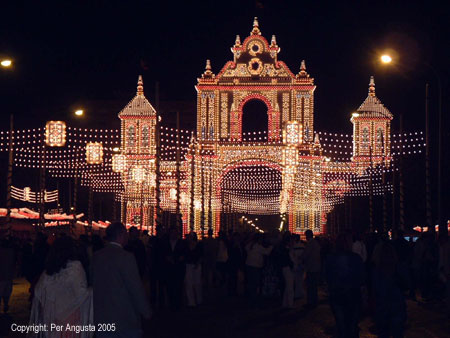
In the Picture Gallery is a larger collection of photos, with more information about the Feria.
How would we rate our Spring Fair experience? Well, it was like nothing we had ever seen before. We had been expecting to see more flamenco dancing but found that unless you were inside a caseta, you didn't get much of a view. However, in the streets of the showground there was spontaneous dancing from time to time. We were lucky to be able to go into the Rotary caseta. I would say that, without the contacts, an afternoon and a night at the Feria would give you plenty to look at and come away with wonderful memories of sights and sounds. Combining that with the many other wonderful sights in Seville would make a great long weekend or even week city break. During the Feria, hotel room prices go through the roof and get booked up very quickly - they also tend to insist on minimum of 3 nights.
We had already been to Seville when we did a tour of Andulacia a couple of years earlier, so this time we revisited a few of our favourite places, found some great tapas bars and walked our feet to tatters. After we had spent 3 days in Seville we headed off into the hills to stay at a renovated olive mill close to Ronda - bliss!
We really like the Andalucian region of Spain and Andalucia has a very good web site which we used extensively to find hotels in Seville and also out near Ronda. Click here to go to the site - there are some great country house hotels listed and we now have a wish list of those we want to visit.